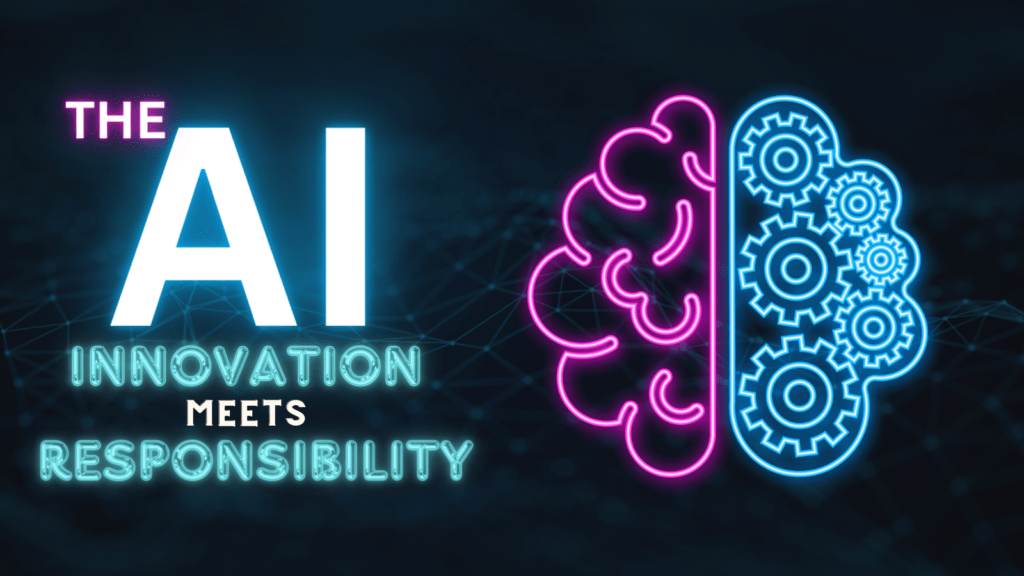TECHNOLOGY
Ethics in AI: Where Innovation Meets Responsibility
Published
7 months agoon

The intersection of innovation and accountability has become a critical focus in the development and implementation of artificial intelligence (AI). Ethical considerations play a crucial role in ensuring that the benefits of AI are balanced with the potential risks and consequences.As organisations and researchers continue to push the boundaries of what is possible with AI, the importance of upholding ethical standards has never been more important.
In this post, we will explore the topic of ethics in AI and its significance in maintaining a responsible and sustainable approach to innovation.Join us as we delve into the complexities of navigating the ethical landscape of AI.

Ethical considerations in AI development:
As the field of AI continues to advance at a rapid pace, it is crucial to address the potential ethical issues that may arise in the development and implementation of AI technology. One of the main concerns is bias in AI algorithms, which can lead to discriminatory outcomes based on race, gender, or other protected characteristics.
For example, if a facial recognition system is trained on a dataset that is primarily made up of white faces, it may struggle to accurately identify individuals with darker skin tones. This can have serious consequences in areas such as law enforcement, where biassed algorithms could perpetuate systemic racism.
Another ethical consideration in AI development is the potential for loss of human control. As AI systems become more advanced and autonomous, there is a risk that they may make decisions without human oversight or intervention. This raises questions about accountability and liability when AI systems make mistakes or cause harm.
For example, if a self-driving car gets into an accident, who is responsible – the manufacturer, the programmer, or the AI system itself? These issues highlight the need for clear regulations and ethical frameworks to govern the development and use of AI technology.
Privacy is another key ethical concern in AI development. As AI systems collect and analyse vast amounts of data about individuals, there is a risk that this information could be misused or compromised. For example, a healthcare AI system that analyses patient data to recommend treatments must ensure that sensitive information is kept secure and confidential.
Companies and developers must be transparent about how data is collected, used, and shared, and obtain informed consent from individuals before using their data in AI applications. An additional ethical issue in AI development is the potential for job displacement. As AI technology automates tasks that were previously performed by humans, there is a risk that many jobs could be eliminated, leading to unemployment and economic inequality.
It is important for policymakers and businesses to consider the social impact of AI deployment and invest in retraining and reskilling programs to help workers adapt to the changing labour market. This will be crucial in ensuring a just transition to an AI-powered economy.
Impact on society:
The use of AI in decision-making processes, such as in recruitment or loan approvals, raises concerns about bias and fairness.AI algorithms are only as unbiased as the data they are trained on, and if these datasets are biassed or incomplete, it can lead to discriminatory outcomes.
This can perpetuate existing inequalities in society and have negative consequences for marginalised groups.It is essential for policymakers and developers to prioritise fairness and transparency in AI systems to prevent these issues from arising. Furthermore, the deployment of AI in surveillance and monitoring applications can infringe on individuals’ privacy rights.
As AI technology becomes more sophisticated, it has the potential to track and analyse individuals’ behaviour on a massive scale, raising concerns about surveillance capitalism and the erosion of personal freedoms. Striking a balance between security and privacy is crucial to protect individuals’ rights and maintain a democratic society.
Another ethical consideration is the impact of AI on the job market. As AI systems automate tasks previously performed by humans, there is a concern about widespread job displacement and economic inequality. It is essential to develop strategies to reskill and upskill the workforce to adapt to the changing labour market and ensure that the benefits of AI are distributed equitably. Addressing these challenges requires collaboration between government, industry, and academia to create policies that promote workforce development and economic inclusivity.
Regulations and guidelines:
Current regulations and guidelines for AI ethics vary by country and region. In the European Union, the General Data Protection Regulation (GDPR) has provisions that govern the use of AI systems and data protection. The United States does not have specific regulations for AI, but there are guidelines issued by government agencies such as the Federal Trade Commission and the National Institute of Standards and Technology.
Additionally, organisations like the Institute of Electrical and Electronics Engineers (IEEE) have developed ethical standards for AI development. Despite the existence of regulations and guidelines for AI ethics, there are still gaps that need to be addressed. One major challenge is the lack of consistent global standards for AI ethics, leading to potential ethical issues when AI systems are deployed across different jurisdictions.
Additionally, there is a need for more transparency and accountability in AI development processes to ensure that these systems are fair and unbiased. As AI technologies continue to advance at a rapid pace, there is a pressing need for continued development of regulations and guidelines for AI ethics.
This includes addressing issues such as bias and discrimination in AI systems, ensuring transparency in AI decision-making processes, and establishing mechanisms for accountability when AI systems fail to meet ethical standards. Collaboration between governments, industry stakeholders, and academic researchers is essential to develop a comprehensive framework for AI ethics that can be applied globally.
Corporate responsibility:
Companies must recognize the ethical implications of AI technologies and take proactive measures to ensure that their use aligns with moral values and societal norms.This includes considerations of privacy, fairness, transparency, and accountability in AI systems. By embedding ethical principles into the design and implementation of AI, companies can mitigate risks of harm and build trust with stakeholders.
Failing to uphold ethical standards in AI practices can lead to a range of negative consequences for companies. From reputational damage and loss of customer trust to potential legal liabilities and regulatory penalties, the risks of unethical AI practices are significant.
Moreover, unethical AI can perpetuate biases, discrimination, and other harmful outcomes that undermine the credibility and effectiveness of AI technologies. Companies that embrace corporate responsibility in AI not only mitigate risks but also unlock new opportunities for innovation and growth.
By adopting ethical AI practices, companies can differentiate themselves as responsible leaders in the industry, attracting top talent, fostering positive relationships with customers, and building a strong reputation for integrity and transparency. Ethical AI can also enhance the performance and reliability of AI systems, leading to better outcomes for businesses and society as a whole.

Transparency and accountability:
Transparency in AI decision-making processes not only fosters trust but also allows for potential biases and errors to be identified and addressed.When algorithms are shrouded in secrecy, it becomes difficult to hold accountable those responsible for unethical actions or outcomes.
By shedding light on the inner workings of AI systems, we empower individuals to challenge and scrutinise the decisions being made, ultimately promoting a culture of accountability within the industry. Holding individuals and organisations accountable for unethical actions in the realm of AI is essential for maintaining the integrity and legitimacy of these technologies.
Whether it be discrimination in hiring practices or biassed decision-making in financial services, it is essential that those responsible for these actions are held to account. By establishing clear guidelines and consequences for unethical behaviour, we can deter future misconduct and ensure that AI systems are used responsibly and ethically.
Furthermore, accountability in AI decision-making processes helps to protect individuals from potential harm or discrimination. When organisations are held accountable for the outcomes of their AI systems, they are incentivized to prioritise the well-being and rights of individuals. By establishing clear lines of responsibility and accountability, we can ensure that AI systems are developed and deployed in a manner that respects the values and rights of individuals.
Bias and fairness:
Bias in AI algorithms poses a significant threat to the fairness of AI systems and can lead to discriminatory practices.These biases can result from the data used to train the algorithms, the design of the algorithms themselves, or the way in which they are implemented.
It is crucial for developers and policymakers to address these biases in order to ensure that AI technologies are fair and equitable for all users.One of the key challenges in addressing bias in AI algorithms is the lack of diversity in the datasets used to train these algorithms.
If the data used to train an AI system is not representative of the entire population, the algorithm may learn and perpetuate biases that exist in the data. For example, if a facial recognition algorithm is trained primarily on data from white individuals, it may perform poorly when attempting to identify individuals with darker skin tones.
To combat this issue, developers must ensure that their datasets are diverse and representative of the population they are aiming to serve. Another common source of bias in AI algorithms is the design of the algorithms themselves. Some algorithms may inadvertently encode biases that exist in society, such as racial or gender stereotypes.
Developers must carefully consider the implications of their design choices and work to mitigate any biases that may be present. This may involve using techniques such as algorithmic auditing, where experts examine the inner workings of an algorithm to identify and address potential biases.
In addition to bias in the data and design of AI algorithms, bias can also creep in during the implementation of these systems. For example, if a predictive policing algorithm is used to allocate resources in a way that disproportionately targets certain communities, this can lead to discriminatory practices. To address this issue, policymakers must establish clear guidelines for the ethical use of AI technologies and regularly monitor their implementation to ensure that they are being used in a fair and responsible manner.
Privacy and data protection:
Privacy and data protection are crucial issues in today’s digital age, particularly with the advent of AI technologies.Ethical considerations surrounding the collection, storage, and use of personal data have become increasingly important as companies and organisations seek to leverage AI for various purposes.
One of the main concerns is the potential for data breaches, which can lead to sensitive information falling into the wrong hands. Safeguards must be put in place to protect user information and ensure that privacy rights are respected.AI technologies have the ability to process vast amounts of data and make predictions with high levels of accuracy.
However, this also means that they have access to a wealth of personal information about individuals. This raises questions about how this data is being used and whether it is being stored securely. There is a growing need for regulations and guidelines to ensure that user privacy is protected and that data is used ethically. In addition to protecting user information, there is also a need to consider the impact of AI technologies on society as a whole.
This includes issues such as algorithmic bias, which can lead to discriminatory outcomes for certain groups of people. Safeguards must be put in place to prevent these biases and ensure that AI systems are fair and inclusive. This is not only an ethical imperative but also a legal one, as companies are increasingly being held accountable for the actions of their AI systems.
Transparency is key when it comes to privacy and data protection in AI technologies. Users should be informed about how their data is being collected, stored, and used, and they should have the ability to opt out if they so choose. Companies and organisations must be upfront about their data practices and be held accountable for any breaches or misuse of information. This will help to build trust with users and ensure that their privacy rights are respected.
Stakeholder engagement:
Stakeholder engagement in discussions surrounding the development of artificial intelligence (AI) is paramount in ensuring ethical considerations are prioritised. By involving a diverse range of stakeholders, including policymakers, researchers, and the public, we can gain valuable perspectives and insights that can help shape the future of AI in a responsible and transparent manner.
Policymakers play a crucial role in shaping the regulatory framework for AI technology. Engaging policymakers in discussions around AI development helps to ensure that ethical guidelines and regulations are in place to protect individuals and society as a whole. By involving policymakers early on in the conversation, we can work towards creating a more inclusive and ethical AI landscape.
Researchers are at the forefront of AI development and have the technical expertise to navigate complex ethical challenges. Engaging researchers in discussions around AI development allows for a more nuanced understanding of the potential risks and benefits associated with AI technology. By collaborating with researchers, we can work towards developing AI systems that are ethical, transparent, and accountable.
The public also plays a crucial role in shaping the future of AI technology. Engaging the public in ethical discussions around AI development helps to ensure that the values and concerns of society are taken into account. By involving the public in decision-making processes, we can build trust and transparency in AI systems, ultimately leading to greater acceptance and adoption of AI technology.
Conclusion:
The intersection of innovation and ethical responsibility in the field of artificial intelligence is paramount.Throughout this article, we have explored the importance of balancing technological advancements with a moral compass to ensure the development and deployment of AI systems that benefit society as a whole.
It is crucial for stakeholders in the AI community to prioritise transparency, accountability, and inclusivity in order to mitigate potential harms and promote societal well-being. Ultimately, by embracing ethical considerations in tandem with innovation, we can create a future where artificial intelligence serves as a force for good.
Let us continue to strive for a harmonious balance between progress and responsibility in shaping the future of AI.

I aim to bring you informative and engaging content. With a passion for staying ahead of the curve in the fast-paced world of technology, my goal is to provide readers with in-depth analysis, reviews, and updates on the latest trends and innovations.
I aim to bring you informative and engaging content. With a passion for staying ahead of the curve in the fast-paced world of technology, my goal is to provide readers with in-depth analysis, reviews, and updates on the latest trends and innovations.

You may like
TECHNOLOGY
Integrated or Dedicated Graphics: Find Your Perfect Match
Published
6 months agoon
21 May 2024
Graphics cards are a vital part of modern computing. They are essential for gamers and tech enthusiasts. You may be building a gaming PC or need a reliable setup for everyday use.
You need to understand the differences between integrated and dedicated graphics cards. Within this guide, we’ll present all of the knowledge necessary for success. It will help you make an informed decision.
Graphics Cards: Their Role and Importance
Graphics cards, also known as GPUs, are special hardware. Rendering images, videos, and animations is their primary function. They play a crucial part in a variety of applications.
- Gaming offers high-quality graphics and smooth frame rates.
- Professional Work: Video editing, 3D rendering, and graphic design.
- Everyday Use: Improving the visual experience for general tasks.
Your computer needs a dedicated graphics card. It relies on the integrated graphics processor (IGP) in the CPU. This may work for basic tasks like web browsing and word processing. But it can’t handle demanding applications.

Understanding Integrated Graphics Cards: Pros and Cons
What are integrated graphics cards?
The motherboard, or CPU itself, houses integrated graphics cards. Often found in laptops and budget desktops, they share the system’s RAM. We refer to Intel’s integrated graphics processors as Intel HD Graphics and Intel UHD Graphics. AMD calls it Radeon Vega or Ryzen Vega.
Technical Differences
- Shared Memory: Integrated GPUs use the system’s main memory instead of having their own.
- Lower Power Consumption: They use less power, making them ideal for portable devices.
Pros
- Cost-Efficiency: Integrated GPUs reduce the computer’s cost.
- Lower Power Requirements: Ideal for energy-efficient systems.
- Compact Design: Perfect for laptops and small form-factor PCs.
Cons
- Limited Performance: Not suitable for high-end gaming or professional graphic work.
- Shared resources: Using system RAM can slow down performance.
- Upgradability: To upgrade it independently, you will need a new CPU or motherboard.
Exploring Dedicated Graphics Cards: Advantages and Limitations
What are dedicated graphics cards?
Dedicated graphics cards are standalone units. They possess their own memory (VRAM), which is installed on the motherboard.
Technical Differences
- Dedicated Memory: VRAM speeds up the processing of graphical tasks.
- Enhanced Performance: Higher clock speeds and more cores compared to integrated GPUs.
- More Power Consumption: Dedicated GPUs must have more power and heat management.
Pros
- Superior Performance: Essential for gaming, 3D rendering, and other intensive tasks.
- Customisation and Upgradability: Easier to Upgrade or Replace.
- Better Cooling Solutions: Often, they come with advanced cooling mechanisms.
Cons
- Higher costs: These are more expensive than integrated solutions.
- Increased Power Consumption: This requires more power and, often, more cooling.
- It may not fit in all computer cases due to its larger size.
Critical Differences Between Integrated and Dedicated Graphics Cards
Performance
- The integrated system is adequate for basic tasks and light gaming.
- A dedicated system is necessary for demanding applications and high-end gaming.
Cost
- A budget-friendly option is integrated.
- Dedicated: More expensive due to dedicated memory and higher performance.
Power Consumption
- The integrated feature offers lower power consumption, making it suitable for portable devices.
- The dedicated system uses more power and produces more heat.
Upgradability
- Integrated: limited or no upgradability.
- Dedicated: Easier to upgrade or replace with newer models.
Use Cases
- Integrated: Ideal for everyday computing, media consumption, and casual gaming.
- Dedicated: Ideal for gaming, professional work, and any application requiring high graphical power.
Graphics Cards for Gaming: Performance Metrics and Considerations
Important performance metrics
- Frame Rate (FPS): A higher FPS ensures smoother gameplay.
- Resolution: Dedicated GPUs handle higher resolutions better (e.g., 1440p, 4K).
- In texture-heavy games, more VRAM means better performance.
- Clock Speed: Higher clock speeds improve performance.
Gaming Benchmarks
- Integrated GPUs typically support 720p to 1080p gaming with lower settings.
- Dedicated GPUs: Can handle 1080p to 4K gaming with high to ultra settings.
Considerations for Gaming
- Game Settings: Integrated GPUs may struggle with high graphics settings.
- Dedicated GPUs offer more longevity and future-proofing for gaming needs.
- When choosing a graphics card, consider your budget and gaming preferences.
Example
- NVIDIA GeForce GTX 1650: A budget-friendly dedicated GPU capable of 1080p gaming.
- Intel UHD Graphics 620: An integrated GPU suitable for light gaming and media.
Graphics cards for professional work: considerations and recommendations
Applications That Benefit from Dedicated GPUs
- Video editing offers smooth playback and faster rendering.
- 3D Rendering: Complex tasks must have dedicated graphics power.
- Graphic design encompasses the creation of high-quality images, animations, and visual effects.
Consider dedicated GPUs.
- NVIDIA Quadro RTX 4000: A high-end GPU optimized to handle heavy workloads.
- AMD Radeon Pro WX 7100: Optimised for heavy video editing, 3D rendering, and design workloads.
Considerations for Professional Work
- Consider your budget. Also, consider the apps you’ll use when choosing a graphics card.
- System Requirements: For optimal performance, certain applications may require specific hardware or software.
- Future Upgradability: Consider investing in a higher-end GPU for future upgrades and longevity.
Graphics Cards for General Use: Cost-Efficiency and Everyday Performance
Everyday Tasks
- Web Browsing: Both integrated and dedicated GPUs handle it well.
- Media Streaming: For HD streaming, integrated GPUs are sufficient.
- Office Applications: Minimal graphical power is required, making integrated solutions cheap.
Cost vs. value
- Integrated GPUs provide excellent value for non-intensive tasks.
- Dedicated GPUs: Provide a better long-term investment for users seeking high performance.
Future trends in graphics card technology
Ray tracing and AI
- Ray Tracing: Enhanced lighting effects for more realistic graphics.
- AI Enhancements: AI-driven features like NVIDIA’s DLSS (Deep Learning Super Sampling).
Advances in Integrated Graphics
- Intel Iris Xe: Bringing better performance to integrated solutions.
- AMD Ryzen APUs: Combining strong CPU and GPU performance in one chip.
Sustainability Initiatives
- Energy Efficiency: Researchers are designing new GPUs to be more energy-efficient.
- Recycling Programs: Companies such as NVIDIA and AMD promote recycling old hardware.
You must choose between an integrated and a dedicated graphics card. The choice depends mostly on your needs and budget. Here are a few final tips to help you decide:
- Identify Your Use Case: A dedicated GPU is necessary if gaming or professional graphic work is a priority.
- Consider Budget Constraints: For general use, an integrated GPU is cost-effective.
- Think long-term: Buying a dedicated GPU could future-proof your setup even if you don’t need high performance now.
Understand these differences and trends. Then, you can make an informed decision that fits your needs.

I aim to bring you informative and engaging content. With a passion for staying ahead of the curve in the fast-paced world of technology, my goal is to provide readers with in-depth analysis, reviews, and updates on the latest trends and innovations.
TECHNOLOGY
Unlock Gaming Performance With The Ideal CPU Architecture
Published
6 months agoon
18 May 2024
The Central Processing Unit (CPU) is your machine’s brain in computing. It executes commands and manages tasks quickly and efficiently. Tech enthusiasts and gamers enjoy understanding CPU architectures. It can significantly improve their computing. It helps with everything, from daily tasks to intense gaming. But what exactly is CPU architecture, and why does it matter?
CPU architecture refers to the design and organization of the processor’s parts. It’s about how they interact. It’s not just about clock speeds and core counts. The architecture dictates how well a CPU can perform.
It affects everything, from multitasking to rendering your favourite games. In this post, we’ll explore different CPU architectures and their impact on speed. We’ll also offer practical advice on choosing the right CPU for your needs.

Common CPU architectures
x86 Architecture
Intel developed the x86 architecture. It has been a cornerstone of personal computing for decades. x86 processors are known for their versatility and firm performance. They excel in many applications, from desktop computing to gaming. Key features include the ability to handle complex instructions. It also supports high-performance multithreading.
Here’s a real-life example. Intel’s Core i9 processors use the x86 architecture. They are famous for their strong performance on gaming PCs. They deliver smooth gameplay and high frame rates.
ARM Architecture
The Advanced RISC Machine architecture is different. It is designed for efficiency. Mobile devices and tablets primarily use ARM processors. They are known for using little power and being very efficient. This architecture is gaining traction in other areas. This includes laptops and even servers. It’s because it can deliver outstanding performance with little energy.
Apple’s M1 chip, based on the ARM architecture, is a practical example. It shows excellent performance in everyday tasks and demanding applications. It also maintains good energy efficiency.
RISC-V Architecture
RISC-V is an open-source architecture. It is gaining popularity for its flexibility and potential for customization. It is less widespread than x86 or ARM. But RISC-V offers something unique. This is an advantage for developers. They want to tailor processors to specific applications.
For example, SiFive makes RISC-V processors. They are for embedded systems and IoT devices.
Choosing the Right CPU Architecture for Gaming
When gaming, picking the right CPU design can significantly affect performance. For a long time, x86 processors have dominated this market. However, newer architectures like ARM and RISC-V are gaining traction. Here are some factors to consider: They will help you decide on the best architecture for your gaming needs.
- The x86 architecture is the design platform for many games. Therefore, you may need assistance with other architectures. However, the gaming industry is becoming more inclusive toward non-x86 processors.
- Gamers often have many apps open while playing. So, they need a processor with intense multitasking and multithreading, like an x86. This allows for smoother gameplay without sacrificing system performance.
- Power Efficiency: If you’re a mobile gamer or value energy efficiency, ARM and RISC-V may be better for you. These processors are ranked for power efficiency. This allows for longer battery life while still delivering excellent gaming performance.
- The price varies depending on the processor and its capabilities. Different architectures can have different prices. Consider your budget when choosing between x86, ARM, or RISC-V processors.
Impact on Performance
The exemplary CPU architecture can significantly affect gaming performance. It determines how well your processor can handle tasks and instructions. x86 processors have long been the go-to choice for gamers. But newer architectures like ARM and RISC-V are catching up in raw speed.
Single-Threaded vs. Multi-Threaded Tasks
The CPU architecture is critical. It determines how well a processor handles tasks. Single-threaded tasks are common in many everyday applications. They rely on the individual cores’ speed. Tasks use many threads. They are common in gaming and professional software. They enjoy working together on many cores. Architectures like ARM are great at handling one thread. In contrast, x86 and RISC-V offer strong multithreading.
Overclocking Potential
Overclocking increases a CPU’s clock speed. It goes beyond its default setting. It is another factor to consider when assessing performance. Overclocking is the focus of architectures like x86 and ARM. RISC-V processors may be more flexible due to their open-source nature. But overclocking can also increase power consumption. It can also damage the processor if done incorrectly.
Graphics Performance
Graphics performance is another area where CPU architecture can make a significant impact. High-resolution displays and immersive gaming are on the rise. The need for quality graphic designs is greater than ever. A dedicated graphics card is crucial. However, the CPU also helps with graphics performance. Many new architectures, such as ARM and RISC-V, have built-in graphics. They can easily handle demanding games.
In gaming, a CPU with strong single-threaded performance will deliver smooth gameplay. This holds for titles that lack multithreading optimization. A processor with good multi-threaded abilities will do well. It will excel in modern games that use multiple cores.
Beyond Architecture
While architecture is crucial, several other factors influence CPU performance.
- We measure the processor’s clock speed in GHz. Its core count also affects performance.
- CPU cache is high-speed memory. It stores often-used data, allowing for faster processing. The size and speed of the cache can affect performance.
- Overclocking can improve performance. However, one must exercise caution to prevent any damage to the processor.
- These are extra sets of instructions. Processors can process them better. They improve performance on specific tasks.
- Overclocking and demanding applications create a lot of heat. It would help if you had proper cooling to prevent throttling.
- Clock Speed: Increased clock speeds translate into more efficient processing. However, efficiency also depends on how well the architecture uses these speeds.
- Cache Size: Bigger caches can store more data for quick access. This reduces the time required to retrieve data from the main memory.
- Thermal Design Power (TDP) is lower. It shows better energy efficiency. This is crucial for maintaining performance without overheating.
Future trends in CPU design
Efficient Designs
CPUs are leaning towards designs that balance speed with efficiency. Innovations are leading to faster and less powerful processors. This is crucial for mobile computing and extending battery life.
Emerging Architectures
The new architectures, like Intel’s Alder Lake and ARM’s Cortex-X series, will push CPU limits. These designs focus on hybrid approaches. They combine fast cores with efficient ones to optimize for varied workloads.
Increased parallel processing
The rise of artificial intelligence and machine learning makes parallel processing more critical. Many new processors can handle complex tasks at the same time. This dramatically boosts their performance in these areas.
Open-source designs
Open-source CPU architectures, such as RISC-V, are gaining traction. This is due to their flexibility and customization capabilities. These designs allow for more collaboration and innovation. They lead to unique and powerful processors.
The RISC-V M-Class is a low-power CPU design. It is ideal for microcontrollers in Internet of Things (IoT) devices. It shows the potential for specialized CPUs in this architecture.
Impact on Consumer Technology
CPU architectures are evolving. Consumers can expect more powerful and efficient devices. These devices will be gaming rigs and everyday laptops. The shift to efficient designs will also enable thinner, lighter devices. They won’t compromise on performance. This shift will enhance portability and the user experience.

Practical Advice for Consumers
When it comes to choosing a CPU, there is no one-size-fits-all solution. Consumers must consider their specific needs and budget to make an informed decision. Here are some practical tips to keep in mind when selecting a processor.
- Know your use case: If you’re a gamer, prioritize single-threaded performance. For professional use, multithreading capabilities are essential.
- Don’t overspend. Pricier processors may need more performance. So, compare benchmarks and keep in mind your budget.
- Think about future needs. If you plan to keep your device for a long time, it may be worth investing in a more robust processor now. This will ensure it can handle future updates and software requirements.
- Ensure compatibility. Check that the CPU you choose works with your motherboard and other components.
- Do your research. Understand the specifications and read reviews. They will give you a better idea of how a processor performs in the real world.
Choosing the Right CPU Architecture
When selecting a CPU, consider your primary use cases:
- Look for CPUs with single-threaded solid performance and high clock speeds for gaming. This includes chips like Intel’s Core i9 or AMD’s Ryzen 9.
- Balanced CPUs like Intel’s Core i5 or AMD’s Ryzen 5 have good value. They offer solid performance for everyday tasks.
- Mobile Devices: Laptops and tablets use ARM-based processors like Apple’s M1. They offer a blend of speed and energy efficiency.
Upgrading and overclocking
If you plan to upgrade your CPU or overclock, do thorough research. Follow safe practices to avoid damage. Additionally, you should monitor the temperature constantly and invest in proper cooling solutions for optimal performance.
Staying Informed
Technology is advancing. It’s essential to stay updated on the latest CPU architecture. Research trusted sources for information. These include industry websites, as well as reviews from professionals and users. Staying current with the latest trends can help you make informed decisions. This occurs when purchasing devices or upgrading components.
Understanding technical specifications
Familiarize yourself with key specifications:
- Cores and Threads: With more cores and threads, you can handle more tasks at the same time. This is beneficial for multi-threaded applications.
- Clock speed indicates how fast a core can process instructions. Higher speeds mean better performance.
- Cache Size: An enormous cache can speed up processing. It accomplishes this by storing frequently used data near the CPU.
Future-Proofing Your Technology
Consider long-term needs when choosing a CPU.
- Upgrade Path: Ensure your motherboard supports future CPU upgrades.
- Compatibility: Check compatibility with other components, such as RAM and GPUs.
- Performance Headroom is critical. Choose a CPU that surpasses your current needs. It should be able to handle future software demands.
Understanding CPU architecture is essential for making informed decisions about your computing hardware. It applies to gaming and general computing.
The right CPU can significantly improve your experience. It does this by providing the needed performance and efficiency. CPU designs continue to evolve. Staying informed about the latest trends will help you protect your technology investments.

I aim to bring you informative and engaging content. With a passion for staying ahead of the curve in the fast-paced world of technology, my goal is to provide readers with in-depth analysis, reviews, and updates on the latest trends and innovations.
TECHNOLOGY
SSD vs. HDD: The Superior Storage Option for Your Needs
Published
6 months agoon
16 May 2024
When it comes to gaming, every millisecond counts. The type of storage you pick can hugely affect gaming performance. It can impact loading times, game performance, and how long your device lasts. This post compares solid-state drives (SSDs) and hard disc drives (HDDs). It will help you choose the best gaming storage for your needs.

Introduction to SSDs and HDDs
What is an SSD?
A solid-state drive (SSD) is a storage device that uses NAND-based flash memory to store data. SSDs are unlike traditional HDDs. They have no moving parts. This allows for faster data access and superior durability. SSDs are known for their lightning-fast read and write speeds. They make them perfect for performance-focused applications.
What is a hard disc drive?
A hard disc drive (HDD) is a storage device. It uses spinning discs coated with magnetic material to store data. A moving read/write head reads and writes data. HDDs are slower than SSDs. Nonetheless, they have more storage at a lower cost per gigabyte. This makes them suitable for bulk storage.
Read/Write Operations: Speed and Performance
SSD:
- Speed: SSDs are known for their exceptional speed. They use flash memory to store data. It allows for much faster reading and writing than hard disc drives. This translates to quicker game load times and faster file transfers.
- SSDs have no moving parts. They can access data almost instantly. This provides a smoother gaming experience.
HDD:
- HDDs are slower than SSDs. They use spinning discs to read and write data. This can result in longer load times and slower performance during gaming.
- HDDs are mechanical, so they are prone to latency and lag. This can hurt fast-paced games.
Capacity and Cost per Gigabyte
SSD:
- SSDs have been catching up. But they still offer less storage per dollar than hard drives.
- Cost per Gigabyte: SSDs are more expensive than HDDs. Recent data shows that SSDs cost more per gigabyte. This makes them a pricier option for gamers who want a lot of storage.
HDD:
- Capacity: HDDs offer larger storage capacities at a lower cost. You can easily find HDDs with many terabytes of storage. This is ideal for gamers with extensive game collections.
- Cost per Gigabyte: HDDs are cheaper. They are a cost-effective solution for significant storage needs.
Cost per gigabyte table:
Storage Type: Average Cost per Gigabyte
|————–|———————-|
SSD | $0.10 to $0.20 |
Corrected: HDD: $0.03 to $0.05
Durability and longevity
SSD:
- SSDs are more durable. Drops and shocks are less likely to damage them because they lack moving parts.
- SSDs have a limited number of write cycles. Modern ones, on the other hand, are designed to last for years under everyday gaming use.
HDD:
- Durability: HDDs are more fragile due to their mechanical components. Drops and physical shocks can cause data loss or drive failure.
- HDDs can wear out over time. This is particularly true when they undergo frequent read-write operations. However, they can still last many years if properly maintained.
Portable Devices' Power Consumption and Battery Life Impact
SSD:
- SSDs consume less power than HDDs. This makes them better for gaming laptops and portable devices.
- SSDs use less power. This makes their batteries last longer. This is critical for gamers on the go.
HDD:
- HDDs consume more power due to their moving parts. This can drain the battery faster on portable devices.
- Using an HDD can cut the battery life of gaming laptops. This affects mobility and gaming away from power sources.
Power Consumption Table:
Storage Type | Average Power Consumption
|————–|—————————|
SSD: 2–3 Watts
HDD: 6-7 watts.
Noise level and heat generation
SSD:
- Noise Level: SSDs operate quietly because they have no moving parts.
- SSDs generate less heat. This can make for a cooler and quieter gaming environment.
HDD:
- Noise Level: HDDs can be noisy due to their spinning discs and moving read/write heads.
- HDDs generate more heat. This heat can affect your gaming setup’s temperature.

Suitability for Different Use Cases
SSD:
- Gamers who prioritize speed, performance, and durability are ideal. If you play fast-paced games, an SSD will give you the best experience. It has quick load times and responsive gameplay.
- Use cases include competitive gaming and virtual reality. They also include any scenario where performance is critical.
HDD:
- Ideal for gamers who require large storage capacities at a reasonable price. If you have a vast library of games and are okay with slightly longer load times, an HDD is a cost-effective solution.
- Casual gaming, storing large game libraries, and use cases where budget is a concern.
A Comprehensive Analysis of Various User Types
Tech Enthusiasts
For tech enthusiasts, SSDs are the clear winner. They value cutting-edge technology and performance. SSDs have quick data access speeds and are durable. This makes them ideal for running virtual machines. They are also great for large-scale software development and other intensive tasks.
Testimonial:
“Switching to an SSD has revolutionised my workflow. Everything is much faster. My system boots up faster, and I can run complex simulations faster.” Alex, tech enthusiast.
Gamers
SSDs facilitate fast load times and smooth gameplay for gamers. An SSD upgrade cuts game loading times a lot. It also boosts gaming performance.
Testimonial:
“After switching to an SSD, my games load almost instantly, and I experience far fewer lag spikes. It’s a game-changer.” Jamie, Gamer.
Small business owners
Small business owners often need a balance between performance and cost. Upgrading to SSDs can boost productivity. They achieve this by reducing boot times and increasing data access. Fast access is crucial for running business apps well.
Data Centres
Data centers and organizations require massive amounts of storage for backups and long-term data. HDDs are a cheap solution. HDDs have a high capacity and are cheap per gigabyte. These traits make them suitable for these use cases, despite lacking the speed of SSDs.
Future trends in storage technology
Technology continues to evolve. The gap between SSD and HDD capabilities is narrowing. New technologies, such as NVMe, are pushing SSDs further. Advances in HDDs are increasing capacities and cutting costs.
Looking ahead, we can expect:
- More people are using solid-state drives. As costs fall, solid-state drives will become more affordable. This will encourage wider usage by all types of users.
- Hybrid solutions are fast. They combine solid-state drives’ speed with hard disc drives’ capacity. They offer the best of both worlds.
- NAND technology is advancing. New developments in NAND flash memory will improve SSDs. They will make it faster and more difficult.
Conclusion: Which storage solution is right for you?
The choice between SSD and HDD depends on your needs and circumstances.
- If you wish, choose SSD.
- High performance
- Faster load times
- more durable storage.
- SSDs are ideal for competitive gamers, as well as those who value speed and efficiency.
- Choose an HDD if you need large storage capacity at a lower cost. HDDs are suitable for casual gamers. They are also good for those who have lots of games. But they must be willing to trade off speed for storage space.
Understand the strengths and weaknesses of both storage solutions. Then, you can make an informed choice. It will improve your gaming.
Ready to upgrade your gaming setup? Consider your priorities. Choose the storage solution that best fits your gaming style and needs. Happy gaming!

I aim to bring you informative and engaging content. With a passion for staying ahead of the curve in the fast-paced world of technology, my goal is to provide readers with in-depth analysis, reviews, and updates on the latest trends and innovations.
Trending
-

 GUIDE7 months ago
GUIDE7 months agoHow to Add Subtitles to YouTube Videos: A Comprehensive Guide
-

 GUIDE6 months ago
GUIDE6 months agoHow to Connect Airpods to Android
-

 GUIDE5 months ago
GUIDE5 months agoHow to Shutdown a PC or Laptop Using a Keyboard
-

 GUIDE5 months ago
GUIDE5 months agoBest Android Games to Play in 2024
-

 TECHNOLOGY6 months ago
TECHNOLOGY6 months agoSSD vs. HDD: The Superior Storage Option for Your Needs
-

 GUIDE6 months ago
GUIDE6 months agoBlock Spam Emails in Gmail: Simple Tricks That Work
-

 TECHNOLOGY6 months ago
TECHNOLOGY6 months agoUnlock Gaming Performance With The Ideal CPU Architecture
-

 GUIDE5 months ago
GUIDE5 months agoHow To Change Background Color On Instagram Story